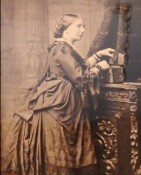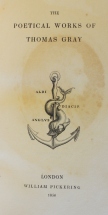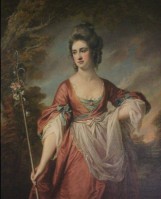 “Read with much fun in 1911, LMY”. Whether this was meant as a sincere expression – or not – of her appreciation of the “indifferent verse” written by Maria Eleanor Vere Cust, her husband’s cousin-once-removed, Louisa Yorke clearly left one of her trademark comments after reading the volume. “Indifferent verse” is how Maria Cust’s biographer describes the poetry presented in Lucem sequor and other poems (1906), and to judge from an earlier privately printed publication, Songs of sunshine and shadow (1903), the comment is fairly apt. Both works at Erddig are inscribed to Maria’s father, the orientalist Robert Needham Cust, for whom she worked as a secretary. Although the name “Cust” appears infrequently in the Erddig book collections outside the Library, it highlights the continuing connections between the two families.
“Read with much fun in 1911, LMY”. Whether this was meant as a sincere expression – or not – of her appreciation of the “indifferent verse” written by Maria Eleanor Vere Cust, her husband’s cousin-once-removed, Louisa Yorke clearly left one of her trademark comments after reading the volume. “Indifferent verse” is how Maria Cust’s biographer describes the poetry presented in Lucem sequor and other poems (1906), and to judge from an earlier privately printed publication, Songs of sunshine and shadow (1903), the comment is fairly apt. Both works at Erddig are inscribed to Maria’s father, the orientalist Robert Needham Cust, for whom she worked as a secretary. Although the name “Cust” appears infrequently in the Erddig book collections outside the Library, it highlights the continuing connections between the two families.
The Yorkes at Erddig were closely related to the Custs of Belton (Lincolnshire), marrying twice into the family. Philip Yorke I (1743-1804) married Elizabeth Cust (1750-79), youngest daughter of Sir John Cust 3rd Bt. in 1770. During the very short period of their marriage, they set about refurbishing Erddig, including the current Library. About 70 years later, Philip and Elizabeth’s grandson, Simon Yorke III (1811-1894) married Victoria Cust (1823-1895), Elizabeth’s grandniece, thus keeping the family connections alive (although this branch lived more locally in the Wirrall). The links between the two families are not only shown in some of the paintings and photographs in the house, but also in the books still kept at Erddig.
Elizabeth’s grandson, Simon Yorke III (1811-1894) married Victoria Cust (1823-1895), Elizabeth’s grandniece, thus keeping the family connections alive (although this branch lived more locally in the Wirrall). The links between the two families are not only shown in some of the paintings and photographs in the house, but also in the books still kept at Erddig.
 One such Cust book is Mrs Hofland’s Panorama of Europe, or a new game of geography (1819), which is inscribed in a child’s hand: “Margaret Cust” – possibly Victoria’s younger sister Margaret Amy Frances (b. 1829), while a copy of their mother’s Invalid’s own book (2nd ed., 1856) – a personal copy, since it contains Mary Anne Cust’s monogram bookplate as well as her signature – also found its way to Erddig.
One such Cust book is Mrs Hofland’s Panorama of Europe, or a new game of geography (1819), which is inscribed in a child’s hand: “Margaret Cust” – possibly Victoria’s younger sister Margaret Amy Frances (b. 1829), while a copy of their mother’s Invalid’s own book (2nd ed., 1856) – a personal copy, since it contains Mary Anne Cust’s monogram bookplate as well as her signature – also found its way to Erddig.

And then there is the volume of The poetical works of Thomas Gray, which has a wonderfully complete provenance history, showing how the was passed between members of the two families. Published in 1836, it was given to the young Victoria Cust by her grandmother, Frances Bankes, Baroness Brownlow of Belton (1756-1847) in 1840. After Victoria’s death in 1895, the book passed to Robert Henry Hobart Cust (1861-1940), the brother of Maria Eleanor Vere Cust, mentioned above. Robert helpfully made a note to the effect underneath the original inscription. For good measure, he also pasted in his armorial bookplate.
complete provenance history, showing how the was passed between members of the two families. Published in 1836, it was given to the young Victoria Cust by her grandmother, Frances Bankes, Baroness Brownlow of Belton (1756-1847) in 1840. After Victoria’s death in 1895, the book passed to Robert Henry Hobart Cust (1861-1940), the brother of Maria Eleanor Vere Cust, mentioned above. Robert helpfully made a note to the effect underneath the original inscription. For good measure, he also pasted in his armorial bookplate.
At some unknown date, Robert then gave the book to his Aunt Etheldred Yorke, the eldest of Victoria’s two daughters. When Etheldred died in 1919, the book came once more into Robert’s hands. Fastidiously Robert recorded this fact as well in the book, this time by means of a pasted in note to present the book with his best wishes to Simon Yorke IV, Victoria’s grandson, in August 1921. Interestingly, Robert’s initial inscription is dated “Aberamffra, January 1895”. This is probably Aberamffra Harbour in Barmouth (Gwynnedd), where Victoria had bought a villa for holidays on the coast. Is it therefore possible that this book only arrived at Erddig for the first time in 1921? That remains to be answered…
as well in the book, this time by means of a pasted in note to present the book with his best wishes to Simon Yorke IV, Victoria’s grandson, in August 1921. Interestingly, Robert’s initial inscription is dated “Aberamffra, January 1895”. This is probably Aberamffra Harbour in Barmouth (Gwynnedd), where Victoria had bought a villa for holidays on the coast. Is it therefore possible that this book only arrived at Erddig for the first time in 1921? That remains to be answered…
Sources
-
Elizabeth Baigent, ‘Cust, Maria Eleanor Vere (1862/3–1958)’, first published 2004 [http://dx.doi.org/10.1093/ref:odnb/49431]
Oliver Garnett, Erddig, National Trust, 1995 (rev. 2011)
thepeerage.com for information about the extended Cust family
The two images of the Cust ladies who married into the Yorke families were taken by myself, with thanks to Sarah of the Erddig houseteam for opening shutters and expertly pointing a light on to Victoria’s photograph portrait.


